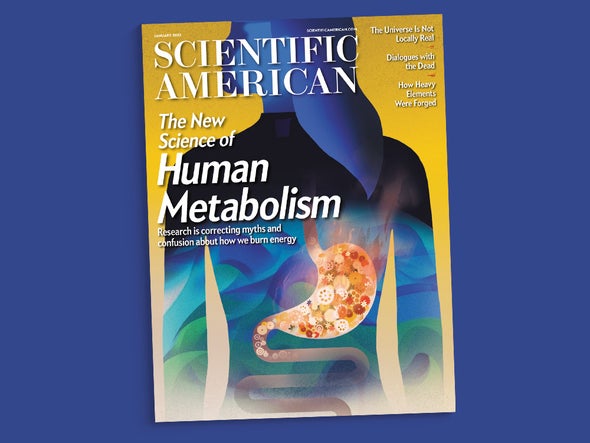
A lot of people have made a lot of money spreading myths and misinformation about metabolism. Nutritional supplement ads, diet books and pseudoscientific health websites claim they can help you boost your metabolism. Sometimes part of the pitch is that metabolism, which is just how your body uses energy, slows down in middle age or that women have a slower metabolism than men. The myths are persistent in part because the diet and supplement industries are so profitable and so poorly regulated. But misinformation also sneaks in because metabolism is really hard to study. Now, as evolutionary anthropologist Herman Pontzer writes in our cover story, scientists have figured out that much of what people think they know about metabolism isn’t true. It doesn’t slow down in middle age, for starters, and there aren’t sex differences. He and his colleagues have also traced the evolution of human metabolism—we use a good deal more energy than other great apes—and provide even more evidence that what makes humans human is cooperation.
Astronomers recently witnessed the synthesis of heavy elements for the first time. It all started when a distant star exploded and its core turned into a dense neutron star. Then its partner in a binary star system did the same. The two neutron stars spiraled into each other in a ripping crash that spilled neutrons into atoms of iron or other lighter elements. The spectacular collision set off gravitational waves that traveled 130 million light-years to Earth, accompanied by light with a spectrum that showed the presence of the heavy element strontium, the first direct observation of a heavy element being forged. Nuclear astrophysicist Sanjana Curtis explains how the heaviest elements are made and why it’s no exaggeration to say that we are made of stardust.
One of our features in this issue is about death and grief and the extinction of languages and cultural traditions … but trust me, it’s a pleasure to read. Anthropologist Piers Vitebsky shares his life’s work among the Sora Indigenous people, who live in highlands of eastern India. He started documenting their language and religious practices in the 1970s and has witnessed massive cultural changes as young Sora convert to more dominant religions. The traditional mourning rituals he describes are among the most elaborate and psychologically astute rites any religion has come up with. He uses the term “theodiversity” to describe what’s being lost as people abandon long-held beliefs about the origins of the world and the nature of life and death.
The 2022 Nobel Prize in Physics went to three scientists who helped to prove that the universe is not locally real. Really. Their work in quantum physics has advanced quantum computing and expanded human knowledge, and it is undoubtedly very important, but it’s also kind of unnerving. Things aren’t “real” unless someone observes them. “Local” refers to the idea that things can be influenced only by their environment, but it turns out that they can be influenced in bizarre and extremely long-distance ways. Science journalist Daniel Garisto chronicles how quantum physics went from crackpottery to a hot field and spells out why quantum entanglement could be both mind-bending and useful. We hope you enjoy what he calls “one of the more unsettling discoveries in the past half a century.”
This article was originally published with the title "Burning Energy" in Scientific American 328, 1, 4 (January 2023)
doi:10.1038/scientificamerican0123-4
"heavy" - Google News
December 13, 2022 at 09:00PM
https://ift.tt/UyNkRir
How Metabolism, Heavy Elements and Quantum Entanglement Really Work - Scientific American
"heavy" - Google News
https://ift.tt/kzd32QH
https://ift.tt/SDqkLwQ
heavy
Bagikan Berita Ini















0 Response to "How Metabolism, Heavy Elements and Quantum Entanglement Really Work - Scientific American"
Post a Comment